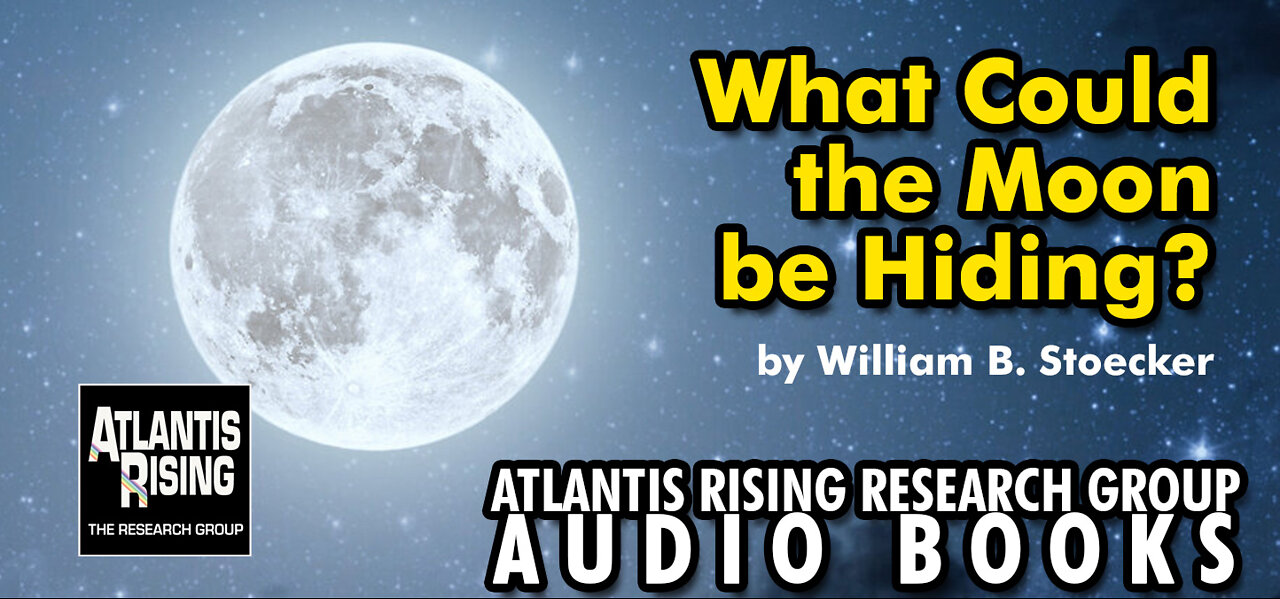Premium Only Content

What Could the Moon be Hiding? From Atlantis Rising Magazine
Visit Atlantis Rising Research Group at https://www.atlantisrising.com/
To say that Earth’s moon is ‘strange’ is an understatement. In fact, the more we learn about our glowing satellite, the stranger and more mysterious it becomes. Relative to the size of the planet it orbits, Earth, it is the largest moon in the Solar System. It is the second densest, after Jupiter’s Io. Moreover, our moon is in synchronous rotation around Earth, meaning that it always presents the same face to us. Prior to the space program, the far side was often referred to as the “dark side,” not because it is dark (any spot on our Moon, save for the polar regions, experiences roughly two weeks of daylight, alternating with about two weeks of night) but because we never see it.
The average density of the Moon is 3.344 grams per cubic centimeter, about 60 percent of Earth’s, which means it is not an artificial, hollow spaceship as some have believed, although there may well be vast caverns in its crust, including lava tubes dwarfing those on Earth (see sidebar). NASA is already considering the astronaut housing possibilities in such immense spaces beneath the surface. These natural caverns have roofs estimated to be tens of meters thick, which would provide protection from the extreme conditions existing above the surface. The habitat would be protected from solar radiation, micro-meteorites, extreme temperature fluctuations—believed to be stable in lava tubes—as well as winds, and regolith dust storms that could threaten human health and technology. These naturally occurring shelters would also reduce the landed payload mass for manned missions and save on the costs of any mining. More on lava tubes later.
The Moon’s relatively low density means that it has fewer heavy elements than Earth, a slightly different chemical composition. But within each element, like oxygen or iron, there are certain ratios of different isotopes, chemically the same but with different numbers of neutrons in their atomic nuclei. The Moon’s isotope ratios are slightly different than those on Earth, making it possible to identify meteorites of lunar origin, presumably blasted off the Moon by asteroid impacts and found on Earth in places like Antarctica, where they are easy to spot and where we also find meteorites from Mars, with a much different isotope ratio.
The Moon’s formation is a mystery yet to be solved. If Earth and Moon had formed from the same accretion disk, they would have a near identical mix of elements and hence a near identical density, but they don’t. Furthermore, the Earth/Moon system has too much angular momentum to have been formed this way. The Moon orbits Earth west to east (the way the Earth turns on its axis) at just 5.14 degrees off our ecliptic—a plane passing through Earth’s equator. Astronomers believe that the odds against Earth capturing a satellite like the Moon are, well, astronomical. For it to be in its west-to-east equatorial orbit as well, though, is just about impossible.
The latest theory to explain the Moon postulates that a Mars-sized object collided with the young Earth after our planet’s nickel-iron core had formed and blasted a mass of our crust and mantle into orbit, where the material gradually cooled and accreted to form the Moon. It turns out, however, that the Moon’s crust on the side facing us is thinner than on the “dark” side, so astronomers have revised the theory and suggested that two satellites formed, and the smaller of the two collided at a low relative velocity with the larger, producing a thicker crust on one side and, as the Moon became tide-locked in synchronous rotation, that side happened to be the far side. But the velocities and angles would have had to be just right, making this formation theory about as improbable as the capture of a satellite. In addition, lava deposits on the Moon contain too much water, and the collision would have boiled off Earth’s water and the Moon’s, as well. Some suggest that the greater thickness of the crust on the far side may be due to more in-falling meteorites and space dust. Since the Moon has been in synchronous rotation for an estimated 3.8 billion years, Earth would likely block much of the material coming in from our side.
-
 0:19
0:19
Atlantis Rising Research Group
2 years agoJoin the ATLANTIS RISING RESEARCH GROUP!
1.05K1 -
 1:15:00
1:15:00
Awaken With JP
9 hours agoMerry Christmas NOT Happy Holidays! Special - LIES Ep 71
130K107 -
 1:42:21
1:42:21
The Quartering
11 hours agoTrump To INVADE Mexico, Take Back Panama Canal Too! NYC Human Torch & Matt Gaetz Report Drops!
109K92 -
 2:23:15
2:23:15
Nerdrotic
10 hours ago $11.42 earnedA Very Merry Christmas | FNT Square Up - Nerdrotic Nooner 453
86.9K11 -
 1:14:05
1:14:05
Tucker Carlson
10 hours ago“I’ll Win With or Without You,” Teamsters Union President Reveals Kamala Harris’s Famous Last Words
173K333 -
 1:58:31
1:58:31
The Dilley Show
10 hours ago $32.63 earnedTrump Conquering Western Hemisphere? w/Author Brenden Dilley 12/23/2024
137K39 -
 1:09:59
1:09:59
Geeks + Gamers
11 hours agoSonic 3 DESTROYS Mufasa And Disney, Naughty Dog Actress SLAMS Gamers Over Intergalactic
93K21 -
 51:59
51:59
The Dan Bongino Show
12 hours agoDemocrat Donor Admits The Scary Truth (Ep. 2393) - 12/23/2024
852K2.81K -
 2:32:15
2:32:15
Matt Kohrs
23 hours agoRumble CEO Chris Pavlovski Talks $775M Tether Partnership || The MK Show
128K31 -
 28:23
28:23
Dave Portnoy
23 hours agoDavey Day Trader Presented by Kraken - December 23, 2024
160K43